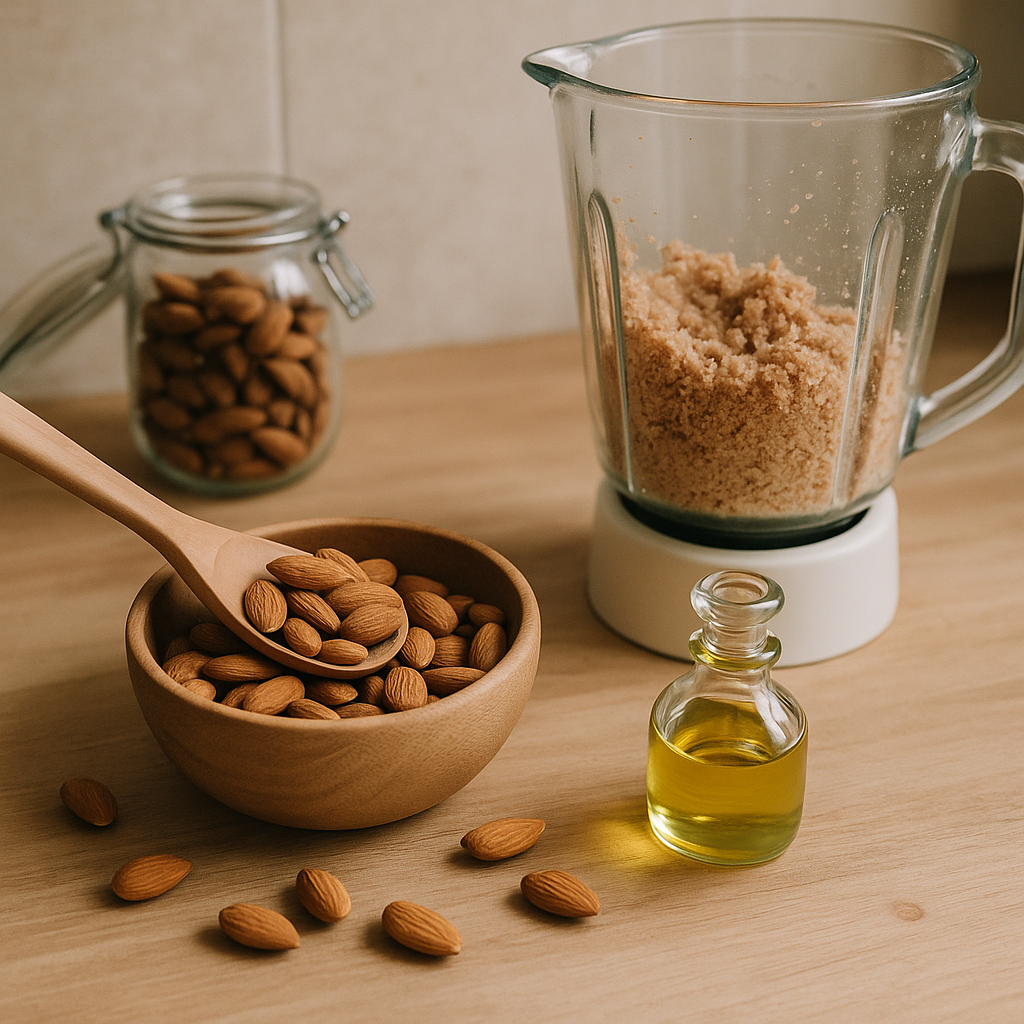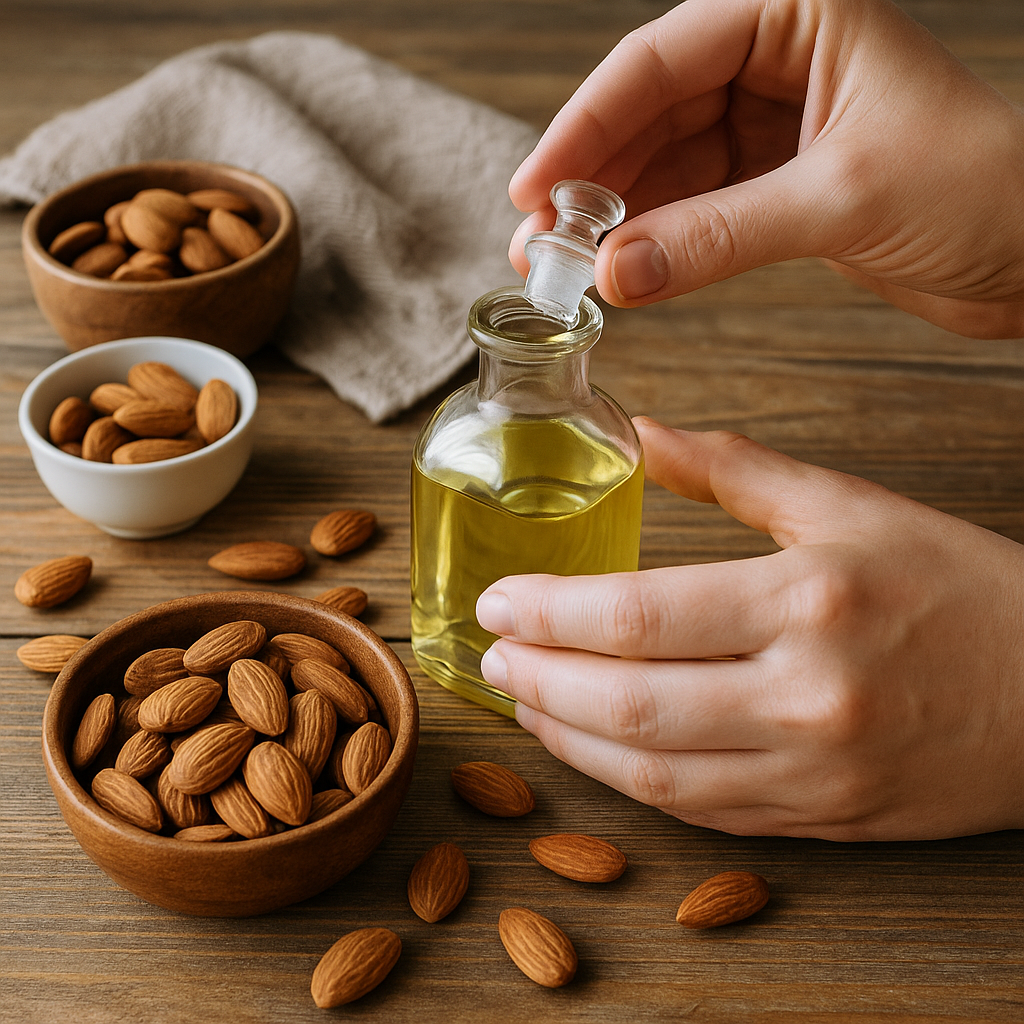Ask Ayurvedic doctor a question and get a consultation online on the problem of your concern in a free or paid mode. More than 2,000 experienced doctors work and wait for your questions on our site and help users to solve their health problems every day.
Shop Now in Our Store
How to Make Almond Oil at Home for Hair, Face, and Skin

Almond oil is a wonderful natural product beloved for its nourishing properties, whether for hair, face, or skin care. But instead of buying it from the store, many people ask: how to make almond oil at home? Making your own almond oil can be surprisingly simple, affordable, and rewarding. Plus, it gives you control over the purity and quality of the oil, ensuring you get nothing but the best for your beauty routine.
In this article, we’ll dive into practical, easy-to-follow steps on how to make homemade almond oil, including tips on cold pressing almonds at home and methods that don’t require fancy equipment like blenders. You’ll learn about the different types of almond oil — like sweet almond oil and cold-pressed almond oil — and how each can benefit your skin and hair. Whether you want to know how to make almond oil at home for hair growth or how to use it as a gentle face moisturizer, this guide covers it all.
So, if you’ve ever wondered can we make almond oil at home and how to do it properly, keep reading for a hands-on tutorial that’ll turn raw almonds into golden liquid gold.
Why Make Almond Oil at Home?
Making almond oil yourself has many benefits beyond just saving money. Store-bought almond oils can sometimes contain additives, preservatives, or be mixed with other oils, which may reduce their effectiveness or cause skin irritation. When you make almond oil at home, you ensure the oil is pure, fresh, and free from any unwanted chemicals.
Plus, homemade almond oil is incredibly versatile. You can customize the oil for specific uses — for example, making almond oil for skin by infusing it with herbs or preparing it as a cold-pressed oil to retain maximum nutrients. This means better nourishment and results when you use it for hair care or skin treatment.
Another reason to make your own almond oil is the satisfaction and connection you feel when crafting a natural product yourself. It’s eco-friendly, too — no plastic packaging waste!

Types of Almond Oil: Sweet, Cold-Pressed, and More
Before jumping into how to make almond oil from almonds at home, it’s good to understand the types of almond oil you can produce. The most common one is sweet almond oil, which is gentle and ideal for all skin types. It’s extracted from the kernels of sweet almonds and is rich in vitamins E and A.
Cold-pressed almond oil is another popular variety. This method involves pressing almonds at low temperatures to extract the oil, which preserves more nutrients and antioxidants compared to oils extracted with heat or chemicals. Many prefer cold pressed almond oil for its purity and enhanced skin and hair benefits.
There’s also bitter almond oil, but it’s mostly used for medicinal or aromatic purposes and isn’t recommended for topical skin use without proper processing.
When you learn how to make sweet almond oil at home or how to make cold pressed almond oil at home, you’re basically choosing the purity and quality you want from your final product.
How to Make Almond Oil at Home Step-by-Step
What You Need: Ingredients and Tools
To make almond oil at home, you’ll need just a few simple ingredients and tools:
-
Raw almonds (preferably organic and unsalted)
-
A grinder or mortar and pestle (if you want to avoid a blender)
-
Cheesecloth or fine mesh strainer
-
A glass jar or bottle for storage
-
A slow cooker, double boiler, or heavy pan (optional for heat extraction)
Some people ask how to make almond oil without blender — and yes, that’s possible! Using a mortar and pestle or even a manual grinder works well if you have the patience.
Instructions to Make Almond Oil Without a Blender
If you don’t have a blender or food processor handy, don’t worry. You can still make almond oil at home using more traditional methods. Start by soaking your raw almonds in water overnight. This softens them, making it easier to crush.
The next day, drain the almonds and use a mortar and pestle to grind them into a coarse paste. This process takes some elbow grease but it’s effective! After grinding, transfer the almond paste into a clean cheesecloth. Squeeze firmly over a bowl to extract the oil. You may not get a huge amount at first, but with practice, the yield improves.
For a richer oil, you can also warm the paste gently in a double boiler for about 30 minutes before squeezing, which helps release more oil. Just be careful not to overheat it, as excessive heat can destroy some of the beneficial nutrients.
How to Make Cold-Pressed Almond Oil at Home
Cold-pressed almond oil is known for its purity and nutrient retention, and making it at home is simpler than it sounds — though it does require patience.
To begin, start with raw, shelled almonds. You can roast them slightly to enhance flavor, but many prefer to press raw almonds for a more delicate oil. The key is to crush or grind the almonds into a fine, moist paste. You can use a blender for this step if you have one.
Once you have the paste, place it in a clean cloth bag or cheesecloth and apply pressure using a manual press or simply by twisting the cloth tightly over a bowl to collect the oil that seeps out. You can repeat this process a couple of times to get as much oil as possible.
Unlike hot-pressed oils, cold pressed almond oil is extracted without heat, preserving vitamins like E and essential fatty acids. This method ensures the oil remains pure and great for sensitive skin and hair.

How to Use Homemade Almond Oil for Hair and Face
Almond Oil for Hair Care
Homemade almond oil is fantastic for hair because it moisturizes, strengthens, and adds shine without weighing hair down. If you’re wondering how to make almond oil at home for hair, using pure, cold-pressed oil is best.
You can apply almond oil directly to your scalp as a massage oil to stimulate blood circulation and promote hair growth. It also soothes dry scalp and reduces dandruff. Just warm a small amount of oil in your hands and massage gently before washing your hair.
For an intensive treatment, apply almond oil to your hair lengths and leave it on overnight, then wash it out in the morning. This helps nourish damaged or brittle hair deeply.
Almond Oil for Face and Skin
Almond oil is gentle enough for most skin types, making it an excellent natural moisturizer. When learning how to make almond oil at home for face, you want your oil to be as pure and fresh as possible to avoid any irritation.
Apply a few drops of almond oil on your face after cleansing. It helps hydrate the skin, reduce dark circles, and improve complexion due to its vitamin E content. You can also mix almond oil with your favorite essential oils or use it as a base for homemade skincare serums.
For dry or sensitive skin, almond oil soothes irritation and inflammation, acting as a natural remedy for conditions like eczema or psoriasis. It’s also great for removing makeup gently without harsh chemicals.
Storage Tips and How to Check Almond Oil Purity
Once you’ve made almond oil at home, proper storage is essential to keep it fresh and effective. Store your almond oil in a clean, airtight glass jar or bottle — preferably dark-colored to protect it from sunlight, which can degrade the oil faster. Keep the container in a cool, dry place away from heat sources.
Homemade almond oil typically lasts about 6 months to a year, depending on how well it’s stored. If you notice a rancid smell or change in color, it’s time to discard it.
To check if your almond oil is pure, look for clarity and smell. Pure almond oil should be light golden and have a mild, nutty scent. If it smells sour or off, it might be contaminated or old.
Conclusion
Learning how to make almond oil at home is a rewarding way to ensure you’re using the purest, freshest oil possible for your hair, face, and skin. Whether you choose the traditional method of pressing almonds without a blender, or prefer the nutrient-rich cold-pressed technique, homemade almond oil offers a natural and customizable beauty solution.
By making almond oil yourself, you’re not only saving money but also avoiding additives and preservatives found in many store-bought oils. Use it regularly to boost hair growth, nourish your skin, and keep your complexion glowing naturally.
So why not try making sweet almond oil at home today? Start your DIY almond oil journey and enjoy the countless benefits this golden elixir offers!
FAQs
How to extract oil from whole almonds?
You can extract oil by crushing or grinding whole almonds into a paste, then pressing or squeezing the paste to release the oil. Soaking almonds overnight softens them and makes oil extraction easier.
How long does homemade almond oil last?
Properly stored homemade almond oil lasts around 6 to 12 months. Keep it in a cool, dark place in an airtight container to maximize shelf life.
How much oil from 1kg almonds?
Typically, you can expect to get about 200 to 250 ml of almond oil from 1kg of raw almonds, depending on extraction method and almond quality.
What type of almonds should I use?
Sweet almonds are best for oil extraction, especially for skin and hair use. Avoid bitter almonds as they require special processing and are not safe for topical use without treatment.
This article is checked by the current qualified Dr Sujal Patil and can be considered a reliable source of information for users of the site.

